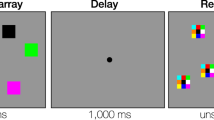Abstract
The effect of Δ 9-tetrahydrocannabinol (Δ 9-THC) and alcohol, singly and in combination, on divided attention performance was investigated in cannabis users and non-users who were matched for alcohol use. Both cannabis and alcohol produced decrements in central and peripheral signal detections. Drug and alcohol effects were greater for signal presentations in the periphery. Cannabis users were less impaired in peripheral signal detection than non-users while intoxicated by cannabis and/or alcohol. These findings suggest the development of tolerance and cross-tolerance in regular cannabis users and/or the ability to compensate for intoxication effects.
Similar content being viewed by others
References
Binder A (1971) An experimental approach to driver evaluation using alcohol drinkers and marihuana smokers. Accident Analysis and Prevention 3:237–256
Brewer N, Sandow B (1980) Alcohol effects on driver performance under conditions of divided attention. Ergonomics 23:185–190
Dubowski KM (1961) Alcohol determination — some physiological and metabolic considerations. Paper presented at the National Conference on Alcohol and Traffic Safety, Pittsburgh
Hockey GRJ (1970) Signal probability and spatial location as possible bases for increased selectivity in noise. Q J Exp Psychol 22:37–42
Jones RT, Stone GC (1970) Psychological studies of marijuana and alcohol in man. Psychopharmacologia 18:108–117
MacAvoy MG, Marks DF (1975) Divided attention performance of cannabis users and non-users following cannabis and alcohol. Psychopharmacologia 44:147–152
McKenna FP (1985) Do safety measures really work? An examination of risk homeostasis theory. Ergonomics 28:489–498
Milner G (1972) Drugs and driving. Karger, Basel
Moskowitz H (1973) Laboratory studies of the effects of alcohol on some variables related to driving. J Safety Res 5:185–199
Moskowitz H, Sharma S (1974) Effects of alcohol on peripheral vision as a function of attention. Hum Fact 16:174–180
Moskowitz H, Burns MM, Williams AF (1985) Skills performance at low blood alcohol levels. J Stud Alcohol 46:482–485
Oppe S (1988) The concept of risk: a decision theoretic approach. Ergonomics 31:435–440
Rafaelson OJ, Bech P, Christiansen J, Christrup H, Nyboe J, Rafaelson L (1973) Cannabis and alcohol: effects on simulated car driving. Science 179:920–923
Smiley A (1986) Marijuana: on-road and driving simulator studies. Alcohol, Drugs and Driving — Abstracts and Reviews 2:121–134
Thompson LJ, Proctor RC (1953) Pyrahexyl in the treatment of alcoholic and drug withdrawal conditions. NC Med J 14:520
Author information
Authors and Affiliations
Rights and permissions
About this article
Cite this article
Marks, D.F., MacAvoy, M.G. Divided attention performance in cannabis users and non-users following alcohol and cannabis separately and in combination. Psychopharmacology 99, 397–401 (1989). https://doi.org/10.1007/BF00445566
Received:
Accepted:
Issue Date:
DOI: https://doi.org/10.1007/BF00445566




